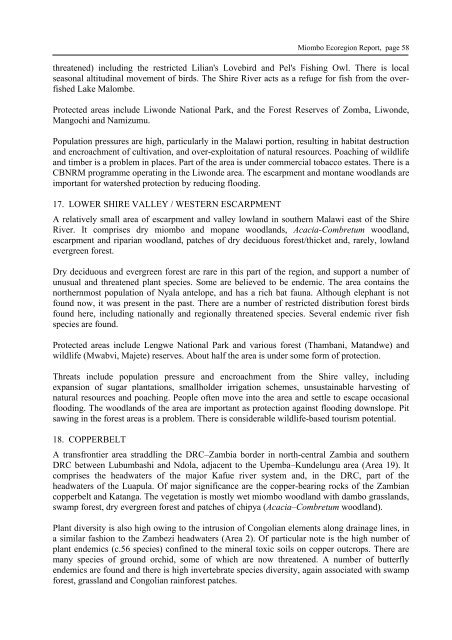Miombo Ecoregion Vision Report - Biodiversity Foundation for Africa
Miombo Ecoregion Vision Report - Biodiversity Foundation for Africa
Miombo Ecoregion Vision Report - Biodiversity Foundation for Africa
Create successful ePaper yourself
Turn your PDF publications into a flip-book with our unique Google optimized e-Paper software.
<strong>Miombo</strong> <strong>Ecoregion</strong> <strong>Report</strong>, page 58<br />
threatened) including the restricted Lilian's Lovebird and Pel's Fishing Owl. There is local<br />
seasonal altitudinal movement of birds. The Shire River acts as a refuge <strong>for</strong> fish from the overfished<br />
Lake Malombe.<br />
Protected areas include Liwonde National Park, and the Forest Reserves of Zomba, Liwonde,<br />
Mangochi and Namizumu.<br />
Population pressures are high, particularly in the Malawi portion, resulting in habitat destruction<br />
and encroachment of cultivation, and over-exploitation of natural resources. Poaching of wildlife<br />
and timber is a problem in places. Part of the area is under commercial tobacco estates. There is a<br />
CBNRM programme operating in the Liwonde area. The escarpment and montane woodlands are<br />
important <strong>for</strong> watershed protection by reducing flooding.<br />
17. LOWER SHIRE VALLEY / WESTERN ESCARPMENT<br />
A relatively small area of escarpment and valley lowland in southern Malawi east of the Shire<br />
River. It comprises dry miombo and mopane woodlands, Acacia-Combretum woodland,<br />
escarpment and riparian woodland, patches of dry deciduous <strong>for</strong>est/thicket and, rarely, lowland<br />
evergreen <strong>for</strong>est.<br />
Dry deciduous and evergreen <strong>for</strong>est are rare in this part of the region, and support a number of<br />
unusual and threatened plant species. Some are believed to be endemic. The area contains the<br />
northernmost population of Nyala antelope, and has a rich bat fauna. Although elephant is not<br />
found now, it was present in the past. There are a number of restricted distribution <strong>for</strong>est birds<br />
found here, including nationally and regionally threatened species. Several endemic river fish<br />
species are found.<br />
Protected areas include Lengwe National Park and various <strong>for</strong>est (Thambani, Matandwe) and<br />
wildlife (Mwabvi, Majete) reserves. About half the area is under some <strong>for</strong>m of protection.<br />
Threats include population pressure and encroachment from the Shire valley, including<br />
expansion of sugar plantations, smallholder irrigation schemes, unsustainable harvesting of<br />
natural resources and poaching. People often move into the area and settle to escape occasional<br />
flooding. The woodlands of the area are important as protection against flooding downslope. Pit<br />
sawing in the <strong>for</strong>est areas is a problem. There is considerable wildlife-based tourism potential.<br />
18. COPPERBELT<br />
A transfrontier area straddling the DRC–Zambia border in north-central Zambia and southern<br />
DRC between Lubumbashi and Ndola, adjacent to the Upemba–Kundelungu area (Area 19). It<br />
comprises the headwaters of the major Kafue river system and, in the DRC, part of the<br />
headwaters of the Luapula. Of major significance are the copper-bearing rocks of the Zambian<br />
copperbelt and Katanga. The vegetation is mostly wet miombo woodland with dambo grasslands,<br />
swamp <strong>for</strong>est, dry evergreen <strong>for</strong>est and patches of chipya (Acacia–Combretum woodland).<br />
Plant diversity is also high owing to the intrusion of Congolian elements along drainage lines, in<br />
a similar fashion to the Zambezi headwaters (Area 2). Of particular note is the high number of<br />
plant endemics (c.56 species) confined to the mineral toxic soils on copper outcrops. There are<br />
many species of ground orchid, some of which are now threatened. A number of butterfly<br />
endemics are found and there is high invertebrate species diversity, again associated with swamp<br />
<strong>for</strong>est, grassland and Congolian rain<strong>for</strong>est patches.


